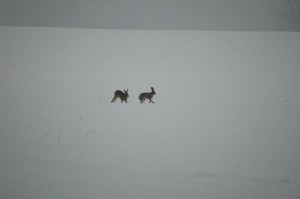Sunday was a lovely day – it didn’t rain and it didn’t blow a gale and the sun shone. Hooray!
I was in Norfolk and saw the odd bird or two and it felt like we were coming towards the end of winter because I also saw…

Carpets of snowdrops.
I like snowdrops – don’t we all? Probably not, because we aren’t all the same.
I like snowdrops because:
- I can identify them and remember their name – an unusual combination for me and plants.
- Their spreading carpets in February brighten up an otherwise rather flowerless time of year.
- They suggest winter is coming to an end and spring may be peeking at us from the distance.

Hares being a bit mad in the fields.
I like Hares because:
- They aren’t Rabbits.
- They run around open landscapes at this time of year looking busy and interesting.
- They remind me of places and times back to my childhood when I have watched them in the past.
And what do they have in common? Well, apart from the fact that they brightened up my Sunday, and that this is a good time of year to see both of them, and despite the fact that they seemed typical of a sunny English February day – neither is (probably) native to the UK. Snowdrops were thought to be native but are now thought to be relatively recent arrivals and Brown or European Hares appears to have been absent from post-glacial Britain until around the times of the Romans (I came, I saw, I brought you the European Hare!).
[registration_form]
Veni, Vidi, Lepi to be precise!
Or even Weeny, Weedy and Leapy (as per 1066 and all that)
I am truly impressed Mark….how many different plants masquerade under the name “snowdrop”? Me…I know a seagull when I see one!
Thanks to Monty Python everyone knows that the Romans did many things for us but were they responsible for introducing the Brown Hare to Britain? The paper you link to appears to think not…
“It thus seems probable that the brown hare was introduced into Britain around 4,000 years ago and began to thrive in the habitats created by Neolithic and later agricultural and land management practices.” The Romans first came here about 2,000 years ago, I believe.
Either way the Hare is a fascinating animal and always a great pleasure to see.
I feel the same way about snowdrops. And hazel catkins. And daffodils. And this year, for the first time, crocuses (or should that be ‘croci’?).
Here’s a website listing some ‘great places to see snowdrops’:
http://www.greatbritishgardens.co.uk/snowdrops.htm
In my ineptitute I failed to make it to Hartland Abbey during eight years living in Devon (sadly it’s currently closed due to storms).
I doubt those dates are accurate but agree snowdrops and hares very special. There is a river valley in Cumbria where the sequence goes:snowdrops, wild daffodils, bluebells, three complete carpets over acres of soggy ground, one after the other. The snowdrop history in your link sounds more like lily of the valley to me.
Wot no Celandines?
I love snowdrops and crocuses but as some one who manages various SSSIs they are in the same catagory as daffodils (which I don’t like so much), Rhododendron (really don’t like) and Himalayan Balsam (really quite pretty) as invasive pests.